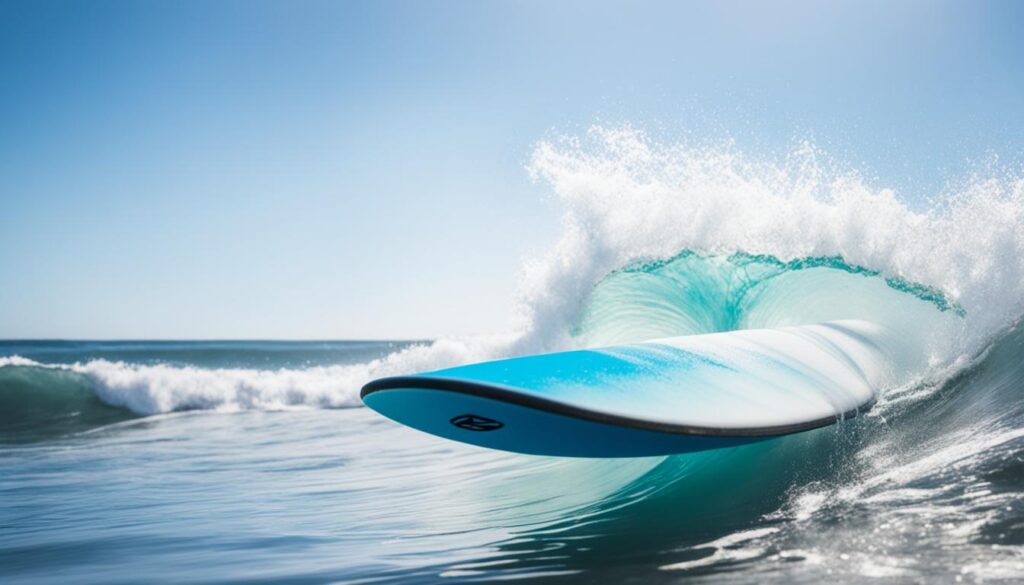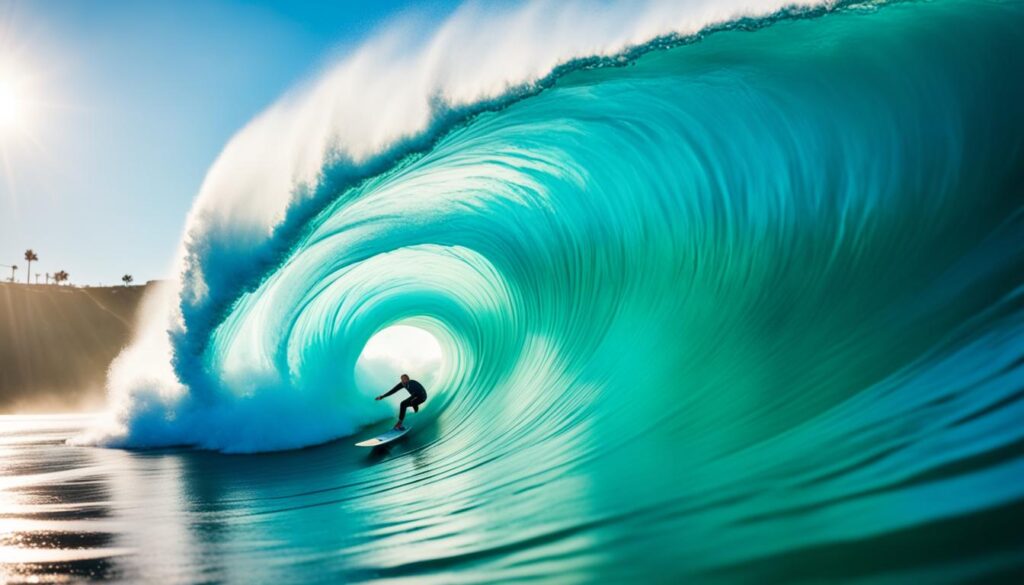Have you ever wondered why surfboards are coated? What is the purpose behind that shiny layer covering the surface of these iconic waves riding tools? Is it purely for aesthetics or does it serve a more profound function? In this article, we will explore the reasons why surfboards are coated, uncovering the benefits of this vital protective layer, and the role it plays in enhancing the performance and durability of these watercraft.
Key Takeaways
- Surfboards are coated to provide protection from water, sun, and impact, extending their lifespan.
- The coating enhances performance by providing better traction and reducing drag in the water.
- Proper coating and maintenance are essential for optimal surfboard performance and durability.
- Manufacturers often provide recommendations for the best coating options and care techniques.
- Understanding the benefits of coating helps surfers make informed decisions about their surfboard care.
The Evolution of Surfboard Materials
Surfboards have come a long way in terms of materials used for their construction. The traditional core material for surfboards has been polyurethane (PU) foam, renowned for its smooth and responsive feel. This foam provides the perfect balance of buoyancy and maneuverability, making it a popular choice among surfers.
However, innovation in surfboard materials has led to the use of alternative foams, such as expanded polystyrene (EPS). EPS foam is lighter than PU foam, making the board more buoyant and suitable for smaller waves. It is often paired with epoxy resin, a versatile adhesive that enhances the board’s durability and strength.
The outer shell of a surfboard is typically comprised of layers of fiberglass cloth and resin. This combination provides the board with the necessary flexibility and strength to withstand the constant pounding of waves. Fiberglass cloth, known for its excellent tensile strength, is layered over the foam core and then saturated with resin. This creates a robust, waterproof shell for the surfboard.
Surfboard construction has further evolved with the incorporation of special materials like carbon fiber, wood veneer, and impact foams. Carbon fiber adds stiffness and responsiveness to the board, allowing for precise control and powerful maneuvers. Wood veneer layers, such as bamboo, not only enhance aesthetics but also provide damping properties, reducing vibrations and adding a unique touch to the board. Impact foams are strategically placed in high-wear areas to improve durability and protect against rail and fin impacts.
With each new material and construction technique, surfboards are becoming lighter, more durable, and more performance-oriented. Surfers now have a wider range of options to choose from, enabling them to find the perfect board that matches their riding style and the characteristics of the waves they surf.
Key Points:
- Polyurethane (PU) foam is the traditional core material for surfboards, known for its smooth and responsive feel.
- Expanded polystyrene (EPS) foam is a lighter alternative that is often combined with epoxy resin for specific wave conditions.
- The outer shell of a surfboard consists of fiberglass cloth and resin, providing flexibility, strength, and waterproofing.
- Carbon fiber, wood veneer, and impact foams are advanced materials used to enhance surfboard construction.
- The use of different materials offers surfers a wide range of options to match their riding style and wave conditions.
Surfboard Wax and Its Benefits
Surfboard wax is a crucial component for surfers looking to maximize their performance on the waves. It provides the necessary grip and traction to maintain balance and execute maneuvers effectively. Applied to the surfboard’s deck, wax enhances the foot-to-board contact, preventing slipping and allowing surfers to ride with confidence.
Not only does surfboard wax improve grip and traction, but it also acts as a protective coating for the surfboard. By guarding against water, sun, and other elements, wax helps to increase the board’s longevity and durability, ensuring it lasts for many surf sessions to come.
When it comes to surfboard wax, different types are available, each offering unique benefits. Basecoat and topcoat waxes are commonly used, providing varying levels of grip and durability. Some surfers prefer a wax that offers maximum traction, while others prioritize durability for prolonged use.
Choosing the right surfboard wax is essential for achieving optimal performance. Consideration should be given to water temperature and surf conditions, as these factors influence wax adherence and performance. Using the appropriate wax for specific conditions can greatly enhance surfboard performance and overall riding experience.
Types of Surfboard Wax
When it comes to surfboard wax, there is a range of options available, each designed to enhance performance in specific ways. Understanding the different types of wax can help you choose the right one for your surfing needs.
Basecoat Wax
Basecoat wax is an essential first layer applied to prepare the surfboard for regular wax application. It creates a stable surface and helps the topcoat stick better, ensuring better grip and traction in the water.
Topcoat Wax
Topcoat wax is the main layer applied directly above the basecoat. It provides the necessary grip and traction for your feet on the board. The specific composition of topcoat wax varies, but its primary goal is to enhance your surfing experience.
Traditional Wax
Traditional wax is a popular choice among surfers. It combines the properties of both basecoat and topcoat waxes and offers a versatile option for those who want a balance of grip, stability, and durability.
Sticky Wax
Sticky wax is specially formulated for surfers who require extra grip in specific areas of their boards, such as where their feet are planted. This type of wax provides targeted traction and is often used by professional surfers for precise maneuvers.
Temperature-Specific Wax
Temperature-specific wax comes in variations suitable for different water temperatures. The wax’s composition and softness are tailored to specific temperature ranges, ensuring optimal performance and maximum grip in varying conditions.
| Wax Type | Main Characteristics |
|---|---|
| Basecoat Wax | Prepares the board for regular wax application, improves topcoat adherence |
| Topcoat Wax | Main layer for grip and traction |
| Traditional Wax | Combines properties of basecoat and topcoat waxes |
| Sticky Wax | Provides extra grip in specific areas |
| Temperature-Specific Wax | Variations suitable for different water temperatures |
Where to Apply Surfboard Wax
The proper application of surfboard wax is crucial for maintaining grip and traction while riding the waves. The placement of the wax depends on the type of surfboard being used, whether it’s a longboard, shortboard, or fun board.
Longboard Waxing
For longboards, it is recommended to apply wax over the entire deck. This is because longboard surfers often walk the length of the board, requiring consistent grip and traction.
Shortboard Waxing
When waxing a shortboard or a fun board, it is sufficient to apply wax to approximately three-fourths of the board, starting from the tail area or where the surfer places their feet. Waxing the nose area can be skipped for these types of boards as it is less frequently used during maneuvers.
Waxing the Rails
Special attention should be given to waxing the rails of the surfboard. The rails are where surfers grab the board and perform tricks, making it essential to have good grip and traction in this area. Concentrating extra wax on the rails ensures a secure hold and enhances maneuverability.
By following these guidelines for wax placement, surfers can optimize their performance and have greater control over their surfboards in various wave conditions.
How to Wax a Surfboard
Waxing a surfboard is an essential part of surfboard maintenance and ensuring optimal performance in the water. Follow these steps to properly wax your surfboard:
- Clean the board: Start by removing any old wax residue from the surfboard. Use a wax comb or scraper to gently scrape off the wax.
- Apply basecoat wax: Once the board is clean, apply a thin layer of basecoat wax to create a textured surface. This basecoat will form a foundation for the topcoat wax and improve grip and traction.
- Choose a waxing technique: Depending on your preference, apply the topcoat wax in a circle pattern, straight line pattern, crosshatch pattern, or freestyle pattern. These techniques ensure even coverage across the board.
- Evenly apply the topcoat wax: Rub the topcoat wax firmly onto the board in your chosen pattern. Apply enough pressure to transfer the wax onto the surfboard’s surface.
- Use a wax comb: After applying the topcoat wax, use a wax comb to create texture and remove any excess or old wax. The comb helps to enhance grip and maintain the wax’s effectiveness.
Proper wax application and techniques are crucial for maintaining optimal performance on the waves. By applying wax in a consistent pattern and using a wax comb for maintenance, you’ll ensure a well-waxed surfboard that provides excellent traction and control.
Keep in mind that waxing techniques can vary based on personal preference, water conditions, and the type of surfboard being used. Experiment with different patterns and find the method that works best for you.
Common Waxing Techniques
| Waxing Technique | Description |
|---|---|
| Circle Pattern | Applying wax in a circular motion, covering the entire surfboard surface. |
| Straight Line Pattern | Applying wax in parallel straight lines from nose to tail or vice versa. |
| Crosshatch Pattern | Applying wax in a crisscross pattern, creating intersecting diagonal lines across the surfboard. |
| Freestyle Pattern | Applying wax in a customized, artistic pattern of your choice, allowing for personal expression. |
Remember that wax will wear off over time, especially with regular use in the water. To maintain optimal performance, reapply wax as needed.
“Waxing a surfboard is like giving it a new pair of shoes – it increases the grip and ensures a solid connection between you and the waves.” – Anonymous
By following proper surfboard waxing techniques and regularly maintaining your wax application, you’ll enjoy improved traction, better maneuverability, and enhanced surfing experiences.
The Role of Resin in Surfboard Laminations
Resin plays a crucial role in surfboard laminations and hot-coating. It is the key ingredient used to create a smooth and protective layer over the fiberglass cloth, enhancing the strength and durability of the surfboard.
Surfboard resin comes in different types, with epoxy and polyester being the most commonly used in surfboard construction. Each resin type offers unique characteristics and benefits, allowing surfboard manufacturers to tailor the performance and properties of the board to specific needs.
Proper resin curing is essential for achieving a high-quality finish and optimal performance. The curing process eliminates any bubbles or imperfections between the laminate layers, ensuring a strong bond and smooth surface. Surfers can rest assured that their boards are built to withstand the rigors of the waves.
In certain cases, fill coats may be applied to fill texture and create a smoother surface before the hot-coating process. This additional layer helps to further strengthen the board and improve the overall aesthetics.
When selecting a resin and determining the application method, surfboard manufacturers consider the specific construction process and desired performance characteristics. The goal is to create a surfboard that meets the needs and preferences of the surfer, delivering superior performance and durability.
“Resin is the backbone of surfboard laminations, providing the necessary strength and protection for a long-lasting and high-performing board.”
Advanced Materials in Surfboard Construction
Innovations in surfboard construction have led to the incorporation of advanced materials, taking the performance and durability of surfboards to new heights. These materials enhance various aspects of the board, providing surfers with specialized enhancements tailored to their preferences and riding styles.
One prominent advanced material used in surfboard construction is carbon fiber. Known for its exceptional strength-to-weight ratio, carbon fiber adds stiffness and liveliness to the board, allowing for more precise control and enhanced maneuverability in the water.
Another material that has gained popularity is wood veneer. Wood veneer layers, such as bamboo, not only offer pleasing aesthetics but also provide damping properties. These layers act as a natural shock absorber, reducing vibrations and enhancing the board’s overall feel and responsiveness.
The use of reinforced composites has also revolutionized surfboard construction. Materials like Vectorply, a widely used reinforcement fabric, enhance torsional stiffness, resulting in improved turning response and performance in critical sections of the wave.
To enhance durability and protection against rail and fin impacts, impact foams are utilized in high-wear areas of the board. These foams offer additional strength and resilience, ensuring the surfboard can withstand the demands of aggressive maneuvers and challenging conditions.
By incorporating these advanced materials into surfboard construction, manufacturers can create customized surfboards that excel in specific conditions and cater to individual rider preferences. Whether it’s a focus on precision control, aesthetics, or durability, the use of advanced materials opens up a range of possibilities for surfers to push their limits and elevate their performance in the water.

| Advanced Materials | Benefits |
|---|---|
| Carbon Fiber | Enhanced stiffness and responsiveness |
| Wood Veneer | Aesthetics and damping properties |
| Reinforced Composites | Improved turning response and performance |
| Impact Foams | Extra durability and protection against impacts |
Selecting the Right Surfboard Materials
When it comes to choosing surfboard materials, several factors come into play. From skill level and wave size to surf style and environmental impact, each element influences the selection process to optimize performance and overall satisfaction. Let’s explore the key considerations in finding the perfect surfboard materials.
Skill Level
Whether you’re a beginner or an experienced surfer, the choice of materials can significantly impact your surfing experience. Beginners often benefit from softer boards, which provide more forgiveness and stability, helping them to gain confidence in the water. On the other hand, experienced surfers may prefer stiffer constructions that offer enhanced control and responsiveness, allowing for more advanced maneuvers.
Wave Size
The size of the waves you typically ride also plays a role in material selection. Larger waves generate greater forces and require more durable materials to withstand the impact. Conversely, smaller waves call for increased buoyancy, and materials that offer enhanced floatation can help maximize the wave-riding experience.
Surf Style
Surfers have unique styles and preferences when it comes to wave riding. Some may favor high-performance maneuvers, while others enjoy a more laid-back and cruisy approach. The choice of surfboard materials can be tailored to individual surfing styles, optimizing board responsiveness, flex, and overall performance.
Environmental Impact
As environmental concerns continue to grow, the surf industry is making strides towards eco-friendly alternatives. Surfers can now choose materials that have less impact on the environment, such as EPS epoxy and wood veneer. By opting for these sustainable options, surfers can enjoy their passion while minimizing their ecological footprint.
Customized Surfboards
For those seeking the ultimate surfboard experience, custom surfboards provide a personalized approach. Customization allows surfers to fine-tune various aspects, including materials, dimensions, and design, based on their specific preferences and requirements. This ensures a surfboard that is tailored to their unique needs, resulting in maximum performance and personal satisfaction in the water.
So, whether you’re a novice or an advanced surfer, ride big or small waves, have a particular surf style, prioritize environmental sustainability, or desire a customized surfboard, considering the right materials is essential for an optimal surfing experience.
| Factors | Skill Level | Wave Size | Surf Style | Environmental Impact | Customization |
|---|---|---|---|---|---|
| Material Considerations | Softer boards for beginners, stiffer constructions for experienced surfers | More durable materials for larger waves, increased buoyancy for smaller waves | Tailored materials for different surf styles and preferences | Eco-friendly alternatives such as EPS epoxy and wood veneer | Customized surfboards based on individual preferences |
The Future of Surfboard Construction
Surfboard construction is on the brink of a revolutionary transformation, thanks to the advent of 3D printing technology. This breakthrough innovation opens up a world of possibilities for surfers, offering precise customization and endless design options. With 3D printing, surfboards can now be tailored to meet specific requirements, optimizing both performance and aesthetics.
The customization potential of 3D-printed surfboards is unparalleled. Surfers can now experiment with different shapes, sizes, and materials, pushing the boundaries of design. Whether you prefer a board that excels in barrel riding or one that provides exceptional stability for noserides, the possibilities are limitless. This level of customization ensures that every surfer can find their ideal board, perfectly suited to their unique style and skill level.
Moreover, 3D printing technology offers not only customization but also the opportunity to explore new materials and manufacturing techniques. Surfboard designers can experiment with lightweight and durable materials that were previously inaccessible. This translates to improved performance, as the weight-to-strength ratio can be optimized for enhanced maneuverability and responsiveness. Furthermore, the use of sustainable and eco-friendly materials can also be maximized, leading to more environmentally conscious surfboard construction.
As technology continues to advance, the future of surfboard construction looks promising. 3D-printed surfboards are just the beginning, with the potential for even more revolutionary advancements on the horizon. From innovative construction methods to intricate designs, surfers can expect ongoing breakthroughs that redefine the possibilities of surfboard manufacturing. The future holds a world where surfers can ride highly customized and precisely engineered boards, bringing their surfing experience to new heights.

